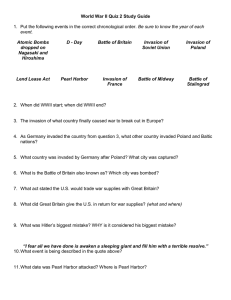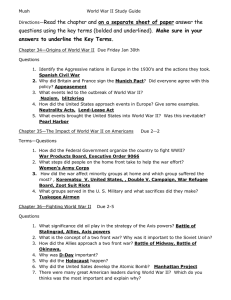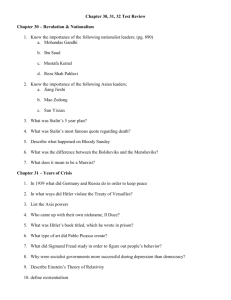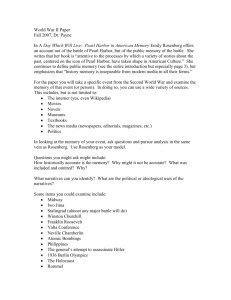World War II Quiz 2 Study Guide event.
advertisement
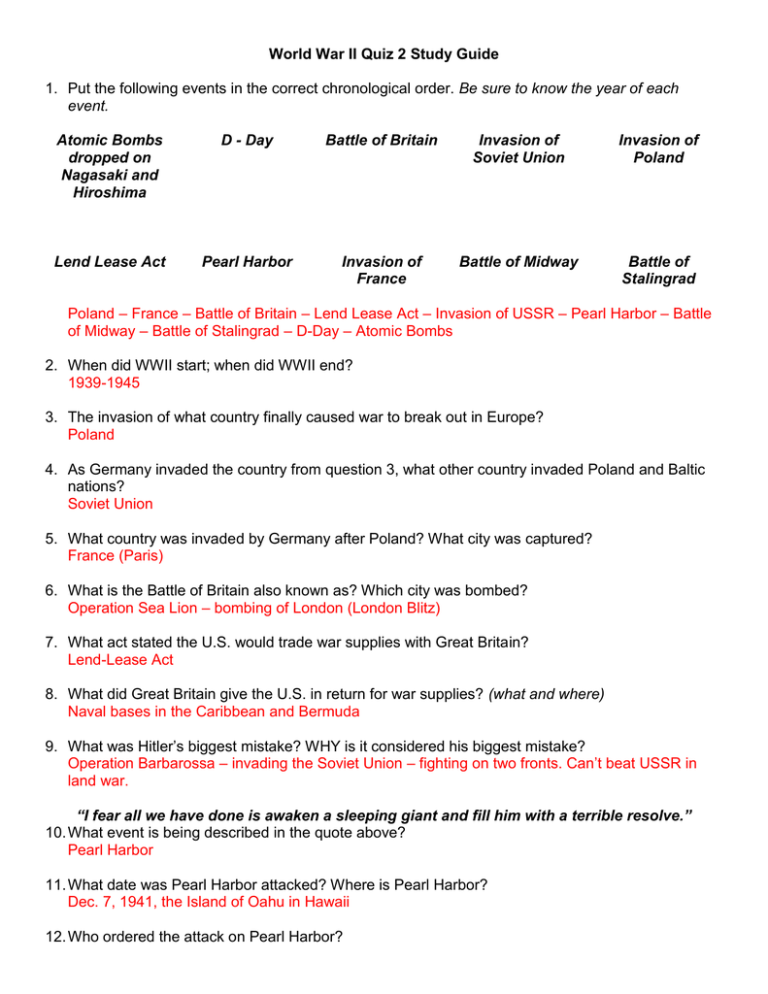
World War II Quiz 2 Study Guide 1. Put the following events in the correct chronological order. Be sure to know the year of each event. Atomic Bombs dropped on Nagasaki and Hiroshima D - Day Battle of Britain Invasion of Soviet Union Invasion of Poland Lend Lease Act Pearl Harbor Invasion of France Battle of Midway Battle of Stalingrad Poland – France – Battle of Britain – Lend Lease Act – Invasion of USSR – Pearl Harbor – Battle of Midway – Battle of Stalingrad – D-Day – Atomic Bombs 2. When did WWII start; when did WWII end? 1939-1945 3. The invasion of what country finally caused war to break out in Europe? Poland 4. As Germany invaded the country from question 3, what other country invaded Poland and Baltic nations? Soviet Union 5. What country was invaded by Germany after Poland? What city was captured? France (Paris) 6. What is the Battle of Britain also known as? Which city was bombed? Operation Sea Lion – bombing of London (London Blitz) 7. What act stated the U.S. would trade war supplies with Great Britain? Lend-Lease Act 8. What did Great Britain give the U.S. in return for war supplies? (what and where) Naval bases in the Caribbean and Bermuda 9. What was Hitler’s biggest mistake? WHY is it considered his biggest mistake? Operation Barbarossa – invading the Soviet Union – fighting on two fronts. Can’t beat USSR in land war. “I fear all we have done is awaken a sleeping giant and fill him with a terrible resolve.” 10. What event is being described in the quote above? Pearl Harbor 11. What date was Pearl Harbor attacked? Where is Pearl Harbor? Dec. 7, 1941, the Island of Oahu in Hawaii 12. Who ordered the attack on Pearl Harbor? Tojo 13. Immediately after Pearl Harbor, the U.S. declared war on what country? What country declared war on the U.S.? Japan then Germany 14. On what two fronts did the U.S. fight on during World War II? Europe and the Pacific 15. What were the turning points of World War II? a. Pacific: Battle of Midway b. Eastern Europe: Battle of Stalingrad c. The beginning of the end of the war in Western Europe: D-Day 16. Who fought in the Battle of Stalingrad? Who won the battle? USSR and Germany. USSR won. 17. What president authorized the use of the atomic bombs? Harry Truman 18. What two cities had an atomic bomb dropped on it? (be sure to know which was first and which was second) Hiroshima, then Nagasaki both in Japan 19. What was the name of the project that created the bomb and who was the leader of the project? Manhattan Project led by Robert Oppenheimer 20. Complete the matching. ___D____ Battle of Britain A. The deadliest battle of World War II. ___B____ Pearl Harbor B. A date that will live in infamy. ___E____ Battle of Midway C. The invasion of Normandy. A deadly battle on French beaches. ___A____ Battle of Stalingrad D. Massive air strike over London. ___C____ D-Day E. The U.S. defeated Japan’s naval strength. 21. What was the motive behind Hitler’s attempt to rid Europe of all Jews? Anti–Semitism and Aryan Supremacy 22. What was the purpose of propaganda in the US during WWII? To influence people’s opinion 23. How were Japanese Americans treated during WWII? (HINT: look in your notes for 2 adjectives.) While many Japanese Americans served in the armed forces, others were treated with distrust and prejudice, and many were forced into internment camps. 24. What did Rosie the Riveter represent and where did some women start to work during WWII? Thousands of American women took jobs in factories -called DEFENSE PLANTS - during the war (Rosie the Riveter) 25. How did the lives of the following changed during the war? African Americans: Racial barriers were temporarily broken due to the need for workers and soldiers. African Americans fought a dual fight – one against segregation at home and one on the battle field in Europe and the Pacific. Consumers: Conserved and rationed resource – Conserved gas, metals, energy/Rationed food and planted victory gardens. Women: Gender barriers were temporarily broken because many women worked in defense plants manufacturing war supplies. 26. What economic system did West Germany have after WWII? East Germany? West = capitalist/ East = Communist 27. Which nations controlled East Germany and West Germany after WWII? East Germany was controlled by the USSR, West German was controlled by the US, Great Britain, and France 28. Which nations were considered superpowers after WWII? The US and the USSR 29. What was the name of the plan to rebuild Europe after the war? Marshall Plan 30. What happened to Germany after the war? Germany was partitioned (divided) into 2 countries – East and West Germany 31. What happened to Japan after the war? What nation occupied it? Japan was occupied by American forces. Soon, Japan adapted a democratic government. 32. What international organization was created after WWII? The United Nations 33. What happened to the American economy after the war? Rapid economic growth and economic boom

